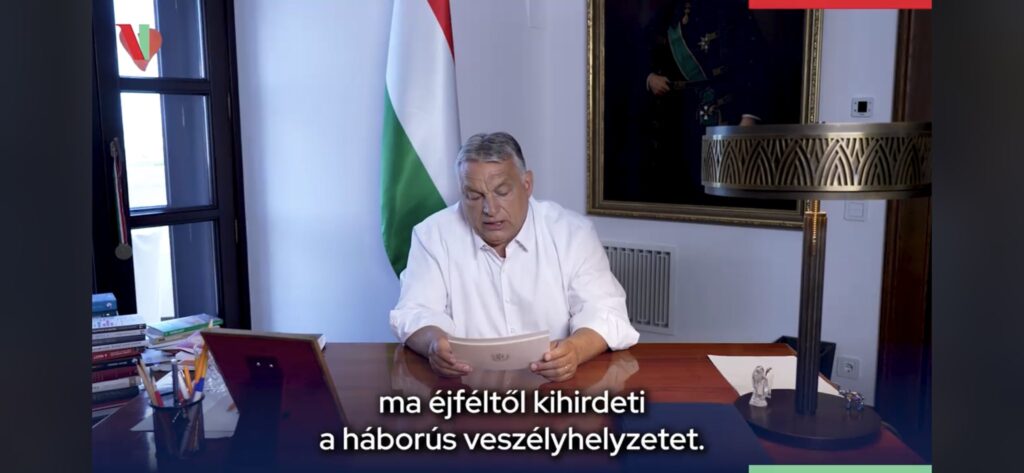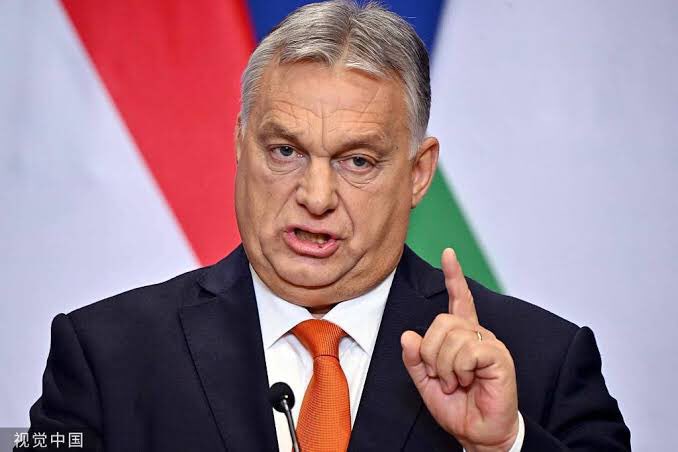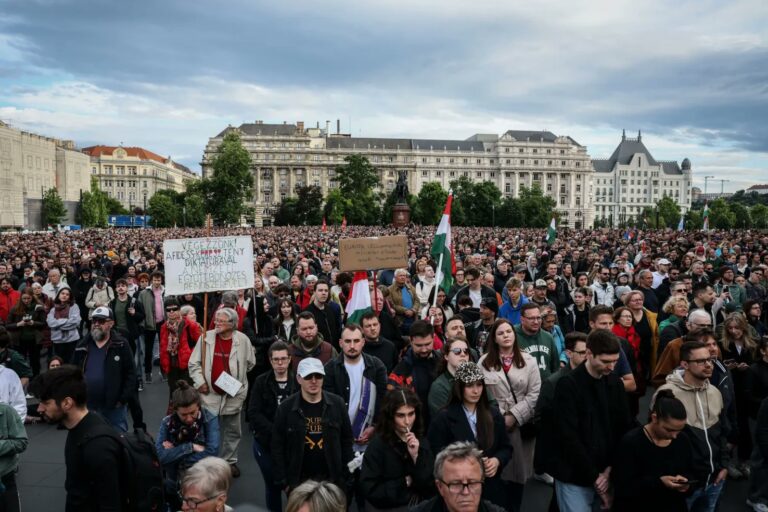On June 111th Budapest protests crystallized growing national unease with creeping authoritarianism—particularly around civic freedoms, media pluralism, and LGBTQ+ rights. Powered by influential civic leaders and supported by political entities now in flux, the movement promises to bolster opposition forces ahead of 2026 elections. Viktor Orbán may gain short-term consolidation, but the deepening social and political backlash might accelerate the erosion of his long-standing dominance.
Core Causes
A. Authoritarian‐style legislation
- A controversial bill now before parliament would allow the government to blacklist or heavily fine foreign‑funded NGOs and media, labeled under “protecting sovereignty.
- Earlier laws have already banned public LGBTQ+ events and empowered facial recognition to penalize protestors—signs of democratic.
B. Widespread fear of creeping authoritarianism
- Artists, journalists, academics, and civic activists warned these laws threaten independent media and civic space .
- The steps echo Russia-style tactics—reminiscent of Hungary’s post-2010 shift—stoking public alarm.
C. Impending elections & growing public dissent
- With the 2026 elections approaching and Fidesz sliding in the polls, the government is resorting to power‑centralizing maneuvers.
- Protesters view their actions as essential to preserving democracy until the ballot box.
2. Movement Architects & Key Figures
A. Cultural and civic influencers
- Around 15,000 people gathered June 10, including writers, musicians, filmmakers, and media personalities.
- Names like Csaba Bogos and musician Dénes Sallai punctuated the event, framing it as the start of a civil resistance movement.
B. Civic groups and NGOs
- The protest is backed by the Citizen Resistance Movement, aHang, Momentum, and others.
- aHang’s political director Viktor Szalóki and campaign director Enikő Tóth emphasized defense of press freedom and civic society.
C. Opposition parties
- The Momentum Movement, previously vocal on transparency issues, is now rallying again under its new leader Márton Tompos .
- Though Momentum may not contest 2026 parliamentary seats, it continues to energize urban and youth voters.
3. Political Beneficiaries
A. Viktor Orbán & Fidesz
- In the short term, hardline measures can galvanize his core base, rally conservative and religious voters, and showcase decisive leadership.
B. Opposition realignment
- Independent civic actors (writers, musicians, NGOs) are gaining prominence, filling a leadership gap and rallying broader public support.
- Momentum Movement stands to consolidate youth and urban votes, positioning itself as a modern, civic‑liberal alternative.
C. Emerging challenger: Péter Magyar’s Tisza party
- Though not directly linked to this protest, the political environment favors his centrist Tisza party, which has successfully unified opposition.
- Growing momentum against Fidesz suggests Magyar’s movement could benefit electorally if these protests keep up.
4. 🗺️ Strategic Implications
- Repressive laws are backfiring: instead of silencing dissent, they’re fueling a broader coalition of cultural, civic, and political forces.
- As Momentum moderates its electoral strategy, other groups like NGOs and civic platforms (aHang, Citizen Resistance) strengthen their influence.
- If protests continue, they could reshape the opposition landscape, pulling it closer to a united electoral force capable of challenging Fidesz.
Based on current polling data and political dynamics, Viktor Orbán faces a real possibility of losing the 2026 parliamentary election.
1. Polling Trends & Seat Projections
- Vox Populi (end‑May 2025): Forecasts Fidesz–KDNP holding ~73–80 seats in a 199-seat parliament—well short of the 100-seat majority needed.
- Medián (Feb–Apr 2025): Shows the new Tisza Party (led by Péter Magyar) at 47% support, versus Fidesz’s 36%—an 11-point gap.
- Daily News Hungary: Confirms similar results, with Tisza leading 46% to Fidesz’s 37% and higher turnout enthusiasm among Tisza voters (90% vs. 80%).
2. Political Context & Headwinds for Orbán
- Economic discontent: Rebounding inflation, stagnating wages, and a drop in birth rate are undermining his traditional “strong economy”.
- International shockwaves: U.S. tariffs, clashes with the EU under Trump, and negative press are tightening the squeeze on his support base .
- Emergence of Tisza Party: Péter Magyar, a former Fidesz insider, has united the fragmented opposition into a two-party challenge—positioning Tisza as the first real rival since 2010.
3. What the Polls Imply
- Loss of majority: Fidesz projections in the 70s (of 199 seats) would fall far short of a viable parliamentary majority.
- Momentum advantage: Tisza’s growing popularity and media enthusiasm suggest they could surpass both Fidesz and smaller parties to form government.
- Voter activation gap: Tisza’s stronger turnout rate gives them a structural edge.
4. Risks & Caveats
- Polling volatility: A year remains, and incumbents often use state resources, media control, and welfare giveaways to shift the tide.
- Fidesz’s resilience: It has weathered scandals before and may yet reenergize support through campaign spending or scapegoating, as seen in 2029.
- Electoral mechanics: Orbán’s camp could tweak district boundaries (“gerrymandering”), capitalize on media control, or manipulate electoral.
🧠 5. Conclusion: A Tight Race—but Tisza Leads
All current polls show a significant lead for Péter Magyar’s Tisza Party. While not definitive, the trend points to Orbán’s first serious electoral threat in over a decade. Assuming no dramatic economic rebound or electoral interference, the probability of a Fidesz loss in 2026 appears substantial, perhaps even likely.
Here’s a scenario-based analysis of Viktor Orbán’s electoral outlook for the 2026 Hungarian parliamentary elections, structured across three strategic outcomes:
🔮 SCENARIO ANALYSIS: ORBÁN’S 2026 PROSPECTS
1. Baseline Scenario: Opposition Victory (Tisza Wins Plurality)
Probability: ~55%
📊 Conditions:
- Tisza Party maintains its polling lead (47–48%)
- Fidesz stays below 40%, fragmented minor parties fail to compensate
- Urban youth and first-time voters turn out in large numbers
- Orbán fails to shift public mood through economic policies or scapegoating
🧩 Outcome:
- Tisza forms a coalition government (likely with Momentum, smaller center-left groups)
- Orbán loses premiership but remains party leader and strong opposition figure
- Hungary enters a transition period with legal battles, possible Fidesz obstruction from within state institutions
⚖️ Implications:
- Possible EU realignment, thaw in EU funds
- Domestic institutional reform begins slowly
- Some risk of unrest from radical Orbán supporters
2. Worst-Case Scenario for Democracy: Orbán Clings to Power
Probability: ~25%
📊 Conditions:
- Fidesz uses legal maneuvers: redistricting, voter suppression, or rule changes
- Media saturation campaigns manipulate undecided voters
- Surge in nationalist rhetoric, possibly invoking “foreign interference” claims
- Opposition fails to coordinate on electoral strategy
🧩 Outcome:
- Fidesz retains slim majority or wins via unfair advantage
- Péter Magyar discredited or weakened as a political outsider
- Orbán claims a “mandate to protect sovereignty,” tightens control post-election
⚖️ Implications:
- EU sanctions likely to return
- Hungary faces partial isolation, potential economic backlash
- Emigration of educated youth intensifies, public protests follow
3. Best-Case for Opposition: Broad Anti-Orbán Coalition Wins Decisively
Probability: ~20%
📊 Conditions:
- Tisza gains 50%+ national support
- Rural discontent breaks Fidesz hold in traditional strongholds
- Unified candidate strategy with small opposition parties
- Major international backing and domestic monitoring ensure clean vote
🧩 Outcome:
- Péter Magyar becomes Prime Minister
- Strong popular and institutional mandate to roll back Orbán-era laws
- Possible internal crisis in Fidesz leads to party split
⚖️ Implications:
- Hungary reintegrates with EU institutions and NATO norms
- Structural reforms (judiciary, education, media) begin rapidly
- Budapest re-emerges as democratic leader in CEE
Strategic Insight:
The baseline and best-case scenarios now outweigh the worst-case—a shift not seen in Hungarian politics in over a decade. However, Orbán remains a political survivor with unmatched media control and a history of deploying last-minute strategies that manipulate outcomes.
Viktor Orbán has a long track record of consolidating power, neutralizing opposition, and using state tools to suppress dissent. Given the scale of recent protests and the rising threat from Péter Magyar’s Tisza Party, Orbán is likely to escalate tactics to maintain control. Here’s how far he could realistically go—and what lines he may or may not cross:
Escalation Ladder: How Far Orbán Might Go to Stop Protests
Low-Level Suppression (Already in Use)
Likelihood: 100% (Ongoing)
- State media propaganda portraying protesters as “foreign agents” or “anarchists”
- Selective arrests of protest organizers using minor public order charges
- Administrative harassment (e.g., fines, bans on gathering locations)
- Smearing opposition leaders through controlled media or leaked material
- Intimidation of students, teachers, and public workers participating in protests
Goal: demoralize and discredit movement without drawing major EU attention.
Medium-Level Suppression (Likely if Protests Grow)
Likelihood: High if protests spread regionally or occupy institutions
- Police violence or aggressive dispersal of larger demonstrations
- Expanded surveillance of opposition figures (already partially deployed)
- Curtailing foreign NGO activity, accusing them of “destabilization”
- Emergency laws to limit gatherings, citing “national security” or “public health”
- Blocking or throttling of independent media websites
This level risks backlash from the EU and international media, but Orbán may bet on a muted Western reaction, especially under the Trump administration.
High-Level Authoritarian Measures (Risky, but Possible in Desperation)
Likelihood: Low to Medium—if regime feels survival is at stake
- Declare a state of emergency ahead of elections to postpone or limit campaigning
- Mass detentions of student and youth leaders under national security laws
- Use of pro-Fidesz paramilitaries or “civic groups” to provoke or intimidate protesters
- Purge of remaining independent judiciary or election commission officials
- Cutting ties with the EU if sanctions or election oversight are threatened
- Curtailing Internet access or social platforms (limited feasibility in EU context)
Such steps would isolate Hungary internationally, risk mass unrest, and accelerate Orbán’s fall—but if he sees no electoral path, desperation may override caution.
🧠 Assessment: How Far Will Orban Go?
Orbán is not likely to use outright martial law or internet shutdowns (à la Belarus) because:
- Hungary is deeply integrated into the EU economy
- He still hopes to manage democratic legitimacy while retaining control
- Fidesz retains significant rural support—it may not yet feel threatened enough
But he will almost certainly escalate to mid-level suppression, including:
- Use of riot police and surveillance
- Criminalization of key activists
- Framing protests as threats to “sovereignty” or national security
Strategy for opposition
1. Maintain Unity and a Singular Opposition Bloc
- No fragmented ballots: All non-Fidesz parties must coordinate under the Tisza umbrella or a common list in each district.
- Avoid the 2022 mistake: In 2022, Orbán exploited a divided opposition. Now, with Tisza polling far ahead, smaller parties should step aside strategically.
- Local deals: Even if formal unity isn’t reached, tactical withdrawal of weak opposition candidates in key constituencies is essential.
- 2. Mobilize Rural and Elderly Voters
- Fidesz still dominates the countryside, older voters, and small towns.
- Opposition must break the Fidesz monopoly in these areas with:
- Direct visits and grassroots organizing,
- Local alliances with mayors and defectors from Fidesz,
- Messaging on practical issues (healthcare, pensions, infrastructure)
3. Turn Out the Urban Youth
- Younger, urban, and first-time voters overwhelmingly support change—but apathy is a risk.
- Tactics:
- TikTok, YouTube, and targeted digital mobilization.
- Leverage the student protest movements and recent demonstrations in Budapest.
- Organize rides to polls and voting drives, especially for students studying outside their home districts
4. Create a Parallel Election Defense Infrastructure
- Orbán’s system may try to suppress or manipulate votes, especially via:
- Gerrymandering
- Unequal media access
- Postal vote irregularities
Solutions:
- Civil society & international observers must be mobilized to:
- Monitor polling stations
- Train volunteer ballot counters
- Set up legal rapid-response teams to challenge irregularities
5. Counter State Media and Narrative Control
- 80%+ of Hungarian media is pro-Fidesz, limiting opposition visibility.
- Tisza and allies must:
- Use alternative media, especially YouTube and independent news platforms.
- Organize town halls and public street events to directly engage people
- Expose corruption and contradictions in Orbán’s narrative (e.g., pro-Russian stance, declining economy)
6. Highlight Bread-and-Butter Issues
- The opposition must focus on what hurts Fidesz’s base, not just abstract democracy arguments.
- Rising prices, declining forint, corruption in COVID and EU funds
- Healthcare system failures, rural poverty, youth exodus
- Use concrete examples and personal stories to undermine the “national protector” image of Orbán.
7. Attract Disillusioned Fidesz Voters
- Many center-right voters are tired of Orbán’s corruption or international scandals but fear instability if he falls.
- Tisza should:
- Emphasize Magyar’s moderate, conservative roots
- Reassure voters of continuity and institutional stability
- Propose a centrist cabinet including professionals, not ideologues
8. Secure International Support and Pressure
- EU and Western governments should:
- Support free and fair elections with observers and diplomatic engagement
- Publicly oppose legal or constitutional manipulations pre-election
- Signal support for a democratic transition and potential post-Orbán economic reset
Orbán can still be beaten—but only through discipline, coordination, and broad coalition-building. The opposition has momentum, but it must not be complacent or overly fragmented.

More on this story: Hungary’s Balancing Act: Strategic Risks of Budapest’s Covert Ties with Russia

More on this story: “Viktor Orbán’s Russian Alignment: A Threat from Within the European Union”




